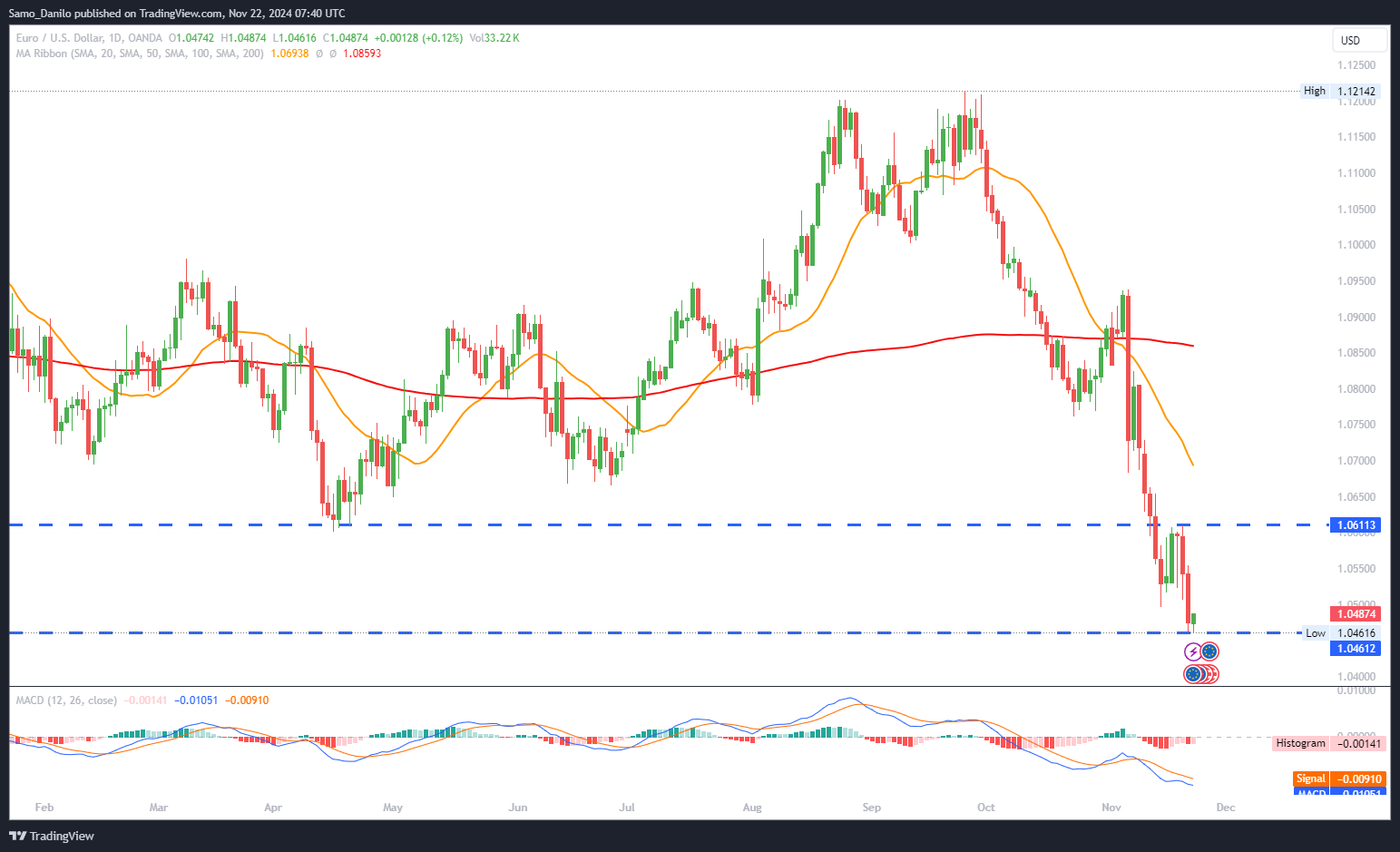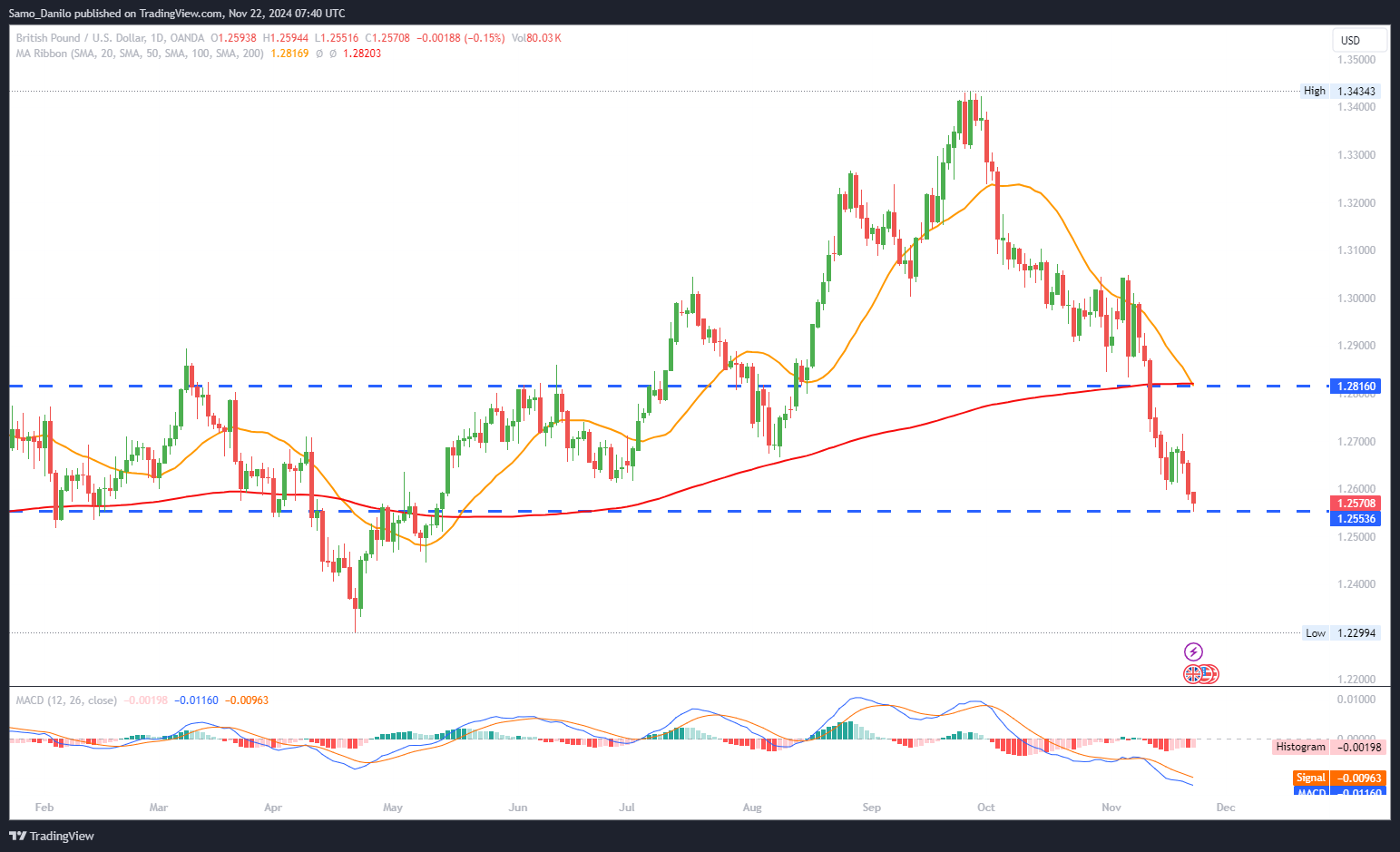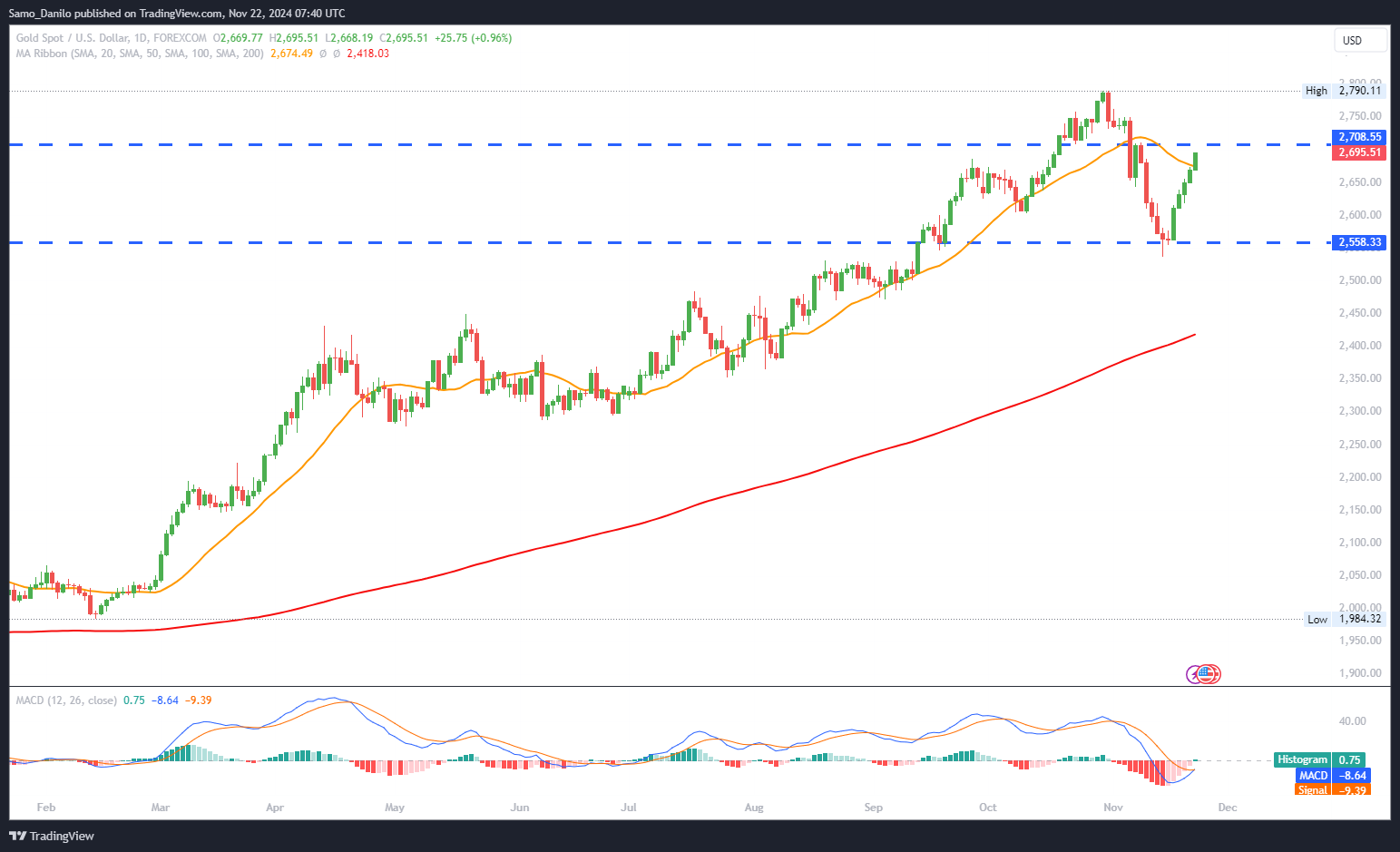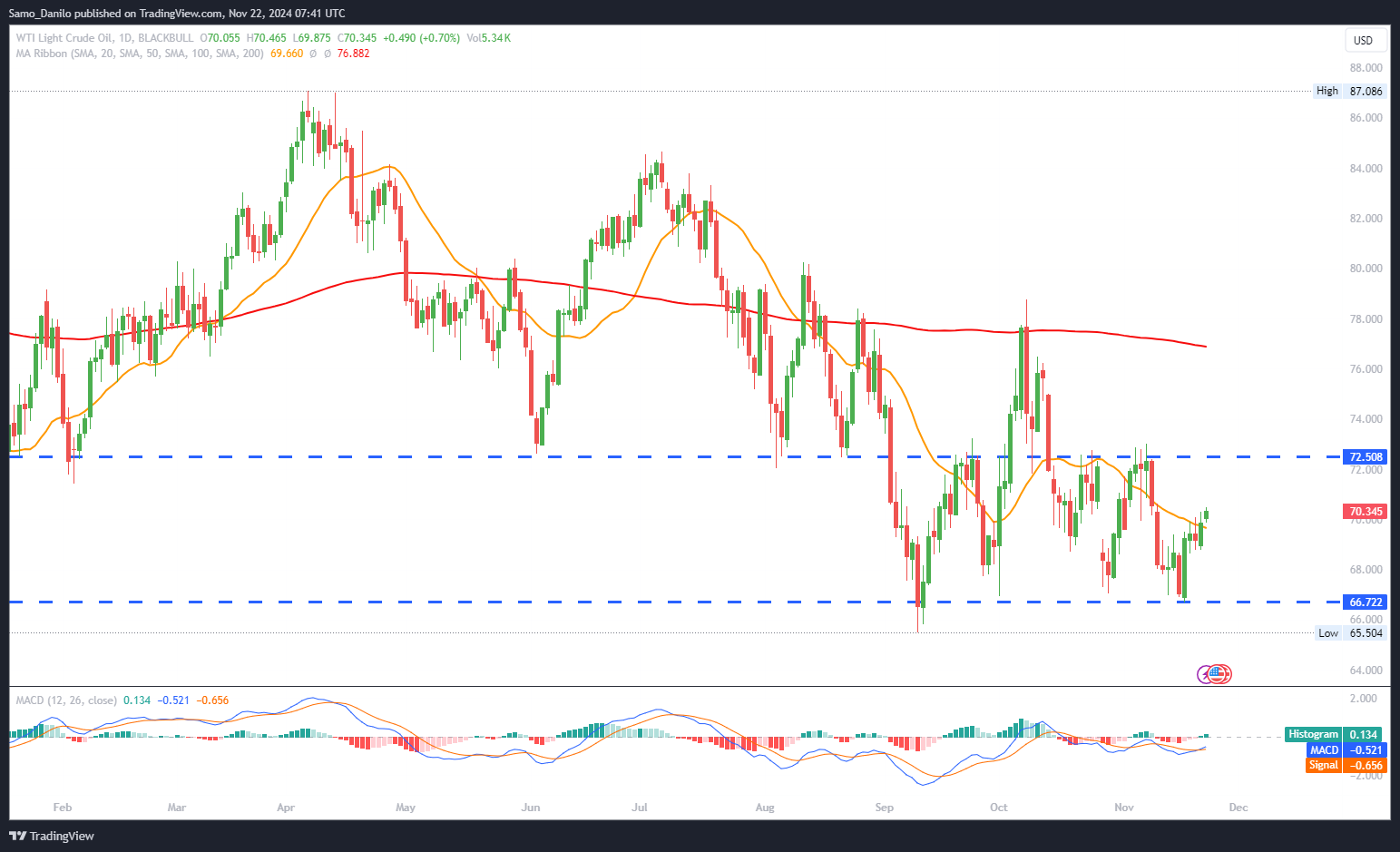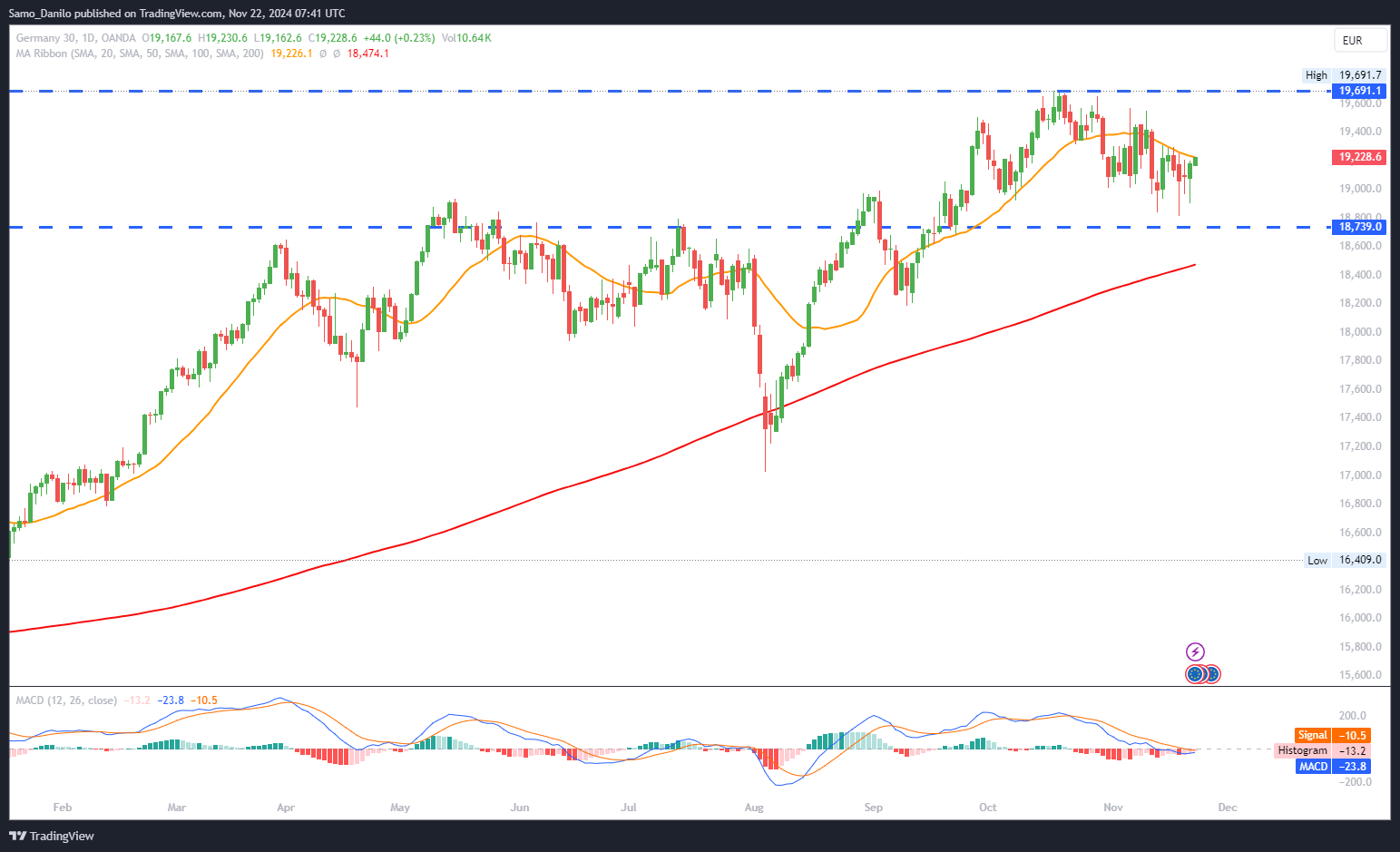EURUSD
- EUR/USD Lows: The pair trades near 1.0470 early Friday, weighed down by persistent US Dollar strength. The Dollar's resilience is supported by the DXY, which hovers near its annual high of 107.15 following strong US Initial Jobless Claims data, highlighting robust economic conditions.
- ECB Policy Expectations: The Euro faces pressure as markets anticipate accelerated policy easing by the European Central Bank (ECB). This dovish outlook contrasts with the Federal Reserve's relatively cautious approach to monetary easing, widening the EUR/USD divergence.
- Eurozone PMI Data: Markets are closely watching the Eurozone HCOB PMI data for November. While the Manufacturing PMI is expected to remain in contraction at 46.0, the Services PMI is forecast to rise slightly to 51.8. These mixed expectations may highlight the ongoing economic divergence within the Eurozone.
- US PMI Data: Later in the day, the release of US S&P Global PMI data could further impact the pair. The US Manufacturing PMI is projected to rise to 48.8 from 48.5, while Services PMI may increase to 55.3, reflecting the resilience of the US economy compared to the Eurozone.
- Persistent USD Strength: The Dollar's strength, fueled by its safe-haven appeal and strong data, continues to dominate market dynamics. The disparity between US and Eurozone economic performance exacerbates the downward pressure on EUR/USD.
Closing statement: EUR/USD remains under pressure amid contrasting economic conditions and diverging central bank policies. Market focus now shifts to PMI releases from both the Eurozone and the US, which will likely shape near-term sentiment. A sustained break below 1.0470 could pave the way for further declines.
GBPUSD
- GBP/USD Lows: GBP/USD extends its losing streak for a third consecutive session, trading near 1.2550, the lowest level since May 2024. The pair remains under pressure amid broader USD strength fuelled by robust US economic data and expectations of a slower Fed rate-cutting pace.
- UK Economic Indicators: The UK GfK Consumer Confidence Index improved to -18 in November, its first rise in three months, signalling slight consumer optimism. However, this was overshadowed by weak Retail Sales data, which fell by 0.7% in October, indicating soft consumer demand following a modest 0.1% rise in September.
- US Jobless Claims: US Initial Jobless Claims dropped to 213,000 for the week ending November 15, below the forecast of 220,000. The better-than-expected data reinforced speculation that the Federal Reserve might slow the pace of rate cuts, further strengthening the Dollar against the Pound.
- Upcoming PMI Data: Traders are now focused on Friday's S&P Global PMI releases for the UK and the US. These data points, coupled with UK Retail Sales figures and the final Michigan Consumer Sentiment report, will likely influence near-term GBP/USD dynamics by offering fresh insights into economic trends in both countries.
- US Dollar Dominance: With the US Dollar maintaining its robust position on the back of strong data and safe-haven flows, the Pound struggles to regain momentum. Diverging economic fundamentals between the UK and the US continue to weigh on GBP/USD.
| SMA (20) | Falling |
|
|
| RSI (14) | Falling |
|
|
| MACD (12, 26, 9) | Falling |
|
|
Closing statement: GBP/USD remains vulnerable as weak UK economic data and USD strength dominate market sentiment. All eyes are on Friday’s economic releases, which could either reinforce the bearish trend or provide a temporary reprieve for the Pound. A sustained break below 1.2550 could open the door for further declines.
GOLD
- Gold Rises: Gold extends its bullish momentum, nearing $2,700, supported by safe haven flows amid persistent geopolitical tensions. XAU/USD remains resilient, even as the US Dollar continues its rally to a yearly high, reflecting gold's independent appeal as a risk-averse asset.
- Geopolitical Escalation: Heightened tensions between Russia and Ukraine, including missile exchanges involving Western weaponry, have intensified market uncertainty. This geopolitical backdrop fuels demand for gold as a hedge against global instability.
- US Economic Concerns: Investors worry that President-elect Donald Trump's potential fiscal policies could trigger higher inflation, prompting the Federal Reserve to adopt a cautious approach to interest rate reductions. Such concerns strengthen gold's allure as an inflation hedge.
- Fed Commentary: Chicago Fed President Austan Goolsbee signaled that inflation is trending toward the 2% target, hinting at a slower pace of rate cuts. These comments have limited gold's upside, but haven flows continue to dominate, keeping XAU/USD supported.
- Gold Unfazed by USD Strength: Despite the USD's extended rally, gold prices remain buoyed, highlighting its robustness in risk-averse environments. This divergence suggests sustained investor confidence in gold's safe-haven appeal.
| SMA (20) | Rising |
|
|
| RSI (14) | Rising |
|
|
| MACD (12, 26, 9) | Slightly Falling |
|
Closing statement: XAU/USD maintains a bullish bias as geopolitical and inflation concerns overshadow the strengthening USD. Investors will closely monitor upcoming Fed commentary and geopolitical developments for further cues. A break above $2,700 could pave the way for continued upside.
CRUDE OIL
- WTI Trades Steady: West Texas Intermediate crude oil remains firm around $70.25, supported by geopolitical tensions and steady demand. The market has absorbed recent price pressures, keeping crude near its weekly highs.
- Geopolitical Risks: Escalating concerns over the Russia-Ukraine conflict, exacerbated by Ukraine's use of Western-supplied missiles against Russian territory, have driven oil prices higher this week. These tensions add to supply uncertainty, keeping oil supported.
- Rising US Stockpiles: The Energy Information Administration (EIA) reported a 0.545- million-barrel increase in US crude oil inventories for the week ending November 15. This rise in stockpiles has tempered the bullish sentiment, balancing the market dynamics.
- US Dollar Strength: Renewed demand for the US Dollar, driven by Federal Reserve commentary on a balanced labor market and inflation moderation, may cap gains for crude oil. A stronger USD makes oil more expensive for non-dollar holders, potentially dampening demand.
- Flash PMIs in Focus: Market participants await the release of global flash Purchasing Managers’ Index (PMI) data for insights into economic health. These metrics could influence broader market sentiment and provide additional direction for oil prices.
| SMA (20) | Slightly Falling |
| |
| RSI (14) | Slightly Rising |
| |
| MACD (12, 26, 9) | Falling |
|
|
Closing statement: WTI faces a tug-of-war between bullish geopolitical risks and bearish factors like rising stockpiles and USD strength. A breakout above $70.50 could signal further gains, while weak PMI data or heightened USD strength may cap upside potential.
DAX
- DAX Rebounds: The DAX rose by 0.74% on Thursday, recovering from Wednesday’s 0.29% decline. Geopolitical tensions and US tariff concerns initially pressured the index to 18,900, but it rebounded on energy and defense stock strength.
- Sector Highlights: Siemens Energy AG led the gains with a 3.62% rise, benefiting from higher oil prices linked to escalating Ukraine war concerns. Defense stock Rheinmetall AG gained 1.61%, driven by potential increases in defense budgets amid heightened geopolitical risks.
- Germany's GDP and PMI Outlook: Germany's Q3 GDP grew by 0.2% quarter-on-quarter according to preliminary estimates. Economists anticipate steady November figures for the HCOB Manufacturing and Services PMIs, signaling resilience in Europe's largest economy despite broader macroeconomic challenges.
- US Labor Market Data: The unexpected drop in US jobless claims to 213k (weekend November 16) highlights a robust labor market. This data supports expectations of sustained private consumption in the US, indirectly influencing global market sentiment.
- Focus on US PMIs: Friday's release of the US S&P Global Services PMI will be closely watched. Any surprises in this data could shape Federal Reserve rate expectations and broader market risk appetite, impacting the DAX indirectly.
| SMA (20) | Rising |
|
|
| RSI (14) | Neutral | ||
| MACD (12, 26, 9) | Falling |
|
|
Closing statement: The DAX remains supported by sectoral strength in energy and defense amid geopolitical risks. Stability in Germany's economic data could maintain upward momentum, while global PMI outcomes might introduce volatility in the next trading session.
